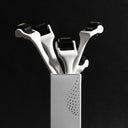While hair loss and androgenetic alopecia are alarming conditions, why does my hair grow so slow is also a common complaint. The normal rate of hair growth is approximately 0.5 inches per month, however, this varies greatly among different individuals.
The majority of the causes of slower hair growth are reversible such as dietary habits and different types of stressors. Subsequent sections will educate the readers on the causes and treatments of slower hair growth.
Table of content
What is a hair growth cycle?

Before discussing the reasons underlying slow hair growth, it is imperative to have background knowledge regarding the normal and natural hair growth cycle. Following are the three key phases of the healthy hair growth cycle.
Anagen Phase
Anagen or growth phase of the hair growth cycle is characterized by the rapid proliferation of melanocytes as well as hair follicular cells. Melanocytes produce an increased concentration of melanin pigment during this stage of the hair cycle.
Rapid activation and division of hair follicular cells cause the hair shaft to grow longer and the extracellular matrix components to increase in concentration.
The anagen phase lasts for approximately two to six years, depending on the location of hair growth. The duration of this phase is proportional to the length of the hair shaft, therefore, relatively longer scalp hair has a relatively longer anagen phase. At any given time, approximately 85-90% of the total hair resides in the anagen phase of the normal hair growth cycle.
Catagen Phase
The phase is also referred to as the transitional or follicular regression stage of the hair growth cycle. During this phase, melanocytes terminate the synthesis of melanin pigment and the proliferation of hair follicular cells also stop. Moreover, the hair follicles regress towards the superficial surface of the scalp.
This transitional phase lasts for only two to three weeks after which the hair follicles enter the final stage of the hair growth cycle, the telogen phase. The characteristic feature of the catagen phase is the formation of club hair.
This hair has a club-like structure at the hair roots formed as the root bulb shrinks. This represents the keratin proteins that are responsible for the formation of the hair strand.
Telogen Phase
The phase is also known as the resting phase of the hair growth cycle. The term 'resting phase' implies that the hair follicles remain dormant during this stage accompanied by complete cessation of hair growth. However, the hair strands remain loosely attached to the hair follicles during this stage.
Scalp hair remains in the telogen for almost a year unit they enter the exogen phase, an extension of the telogen phase characterized by the liberation of hair strands from the hair follicles.
Approximately 10-15% of the total body hair is present in the telogen phase at a given time. Hair shedding may occur during this stage, assisted by activities such as brushing or washing hair. Soon, hair follicles enter the next hair growth cycle.
As your leading source for hair health information over the past 4 years, we never compromise on accuracy. When it comes to your health, you deserve information you can truly rely on - and earning your trust is our top priority.
Here's how Scandinavian Biolabs ensures every piece of content meets the highest standards of accuracy and integrity:
- Credentialed Experts: Our reviewers are actively practicing doctors and medical researchers
- Stringent Reviews: Content undergoes rigorous editing by subject specialists and review by a practicing doctor.
- Evidence-Based: We rely on well-established research from trusted scientific sources like peer-reviewed journals and health authorities.
- Full Transparency: Our editorial standards, writer credentials, reviewer credentials, correction process, and funding are all publicly documented.
- Independent Voice: While we do promote products, we operate in a vacuum to business operations. Our main goal is just an unwavering commitment to providing medically-sound guidance.
You can count on Scandinavian Biolabs to consistently deliver the trustworthy health information you deserve. Read our Editorial Standards.
How fast does hair grow normally?

According to the American Academy of Dermatology, the average rate of growth of hair is half an inch per month or approximately six inches per annum.
However, the provided rate of hair growth is not definitive and may vary among individuals of different ages, sex, race, ethnicity, and genetic makeup i.e. Asian hair type grow and baby hair type. Several environmental, psychological, physiological, and pathological factors also influence the rate of hair growth.
Your hair texture, however, does not affect your growth rate. Curly hair does not grow any faster than other hair textures.
Why does my hair grow so slowly?
In short, hair growth can be influenced by various factors, such as genetics, age, hormonal balance, and overall health. Slow hair growth may result from these factors or external elements like poor diet, stress, and improper hair care.
Hair growth is a complex process. Some possible reasons for slow hair growth include:
- Genetics: Your genetic makeup determines your hair growth rate and hair cycle, which can lead to variations in growth speed.
- Age: As you age, hair growth tends to slow down due to changes in the hair growth cycle and decreased hair follicle activity.
- Hormonal Balance: Hormones, such as thyroid hormones and androgens, play a significant role in hair growth. Imbalances in these hormones can lead to slow hair growth or hair loss.
- Overall Health: Health conditions or nutritional deficiencies can affect hair growth. For example, anemia or protein deficiencies can cause hair to grow more slowly or lead to hair loss.
External factors that may contribute to slow hair growth include:
- Poor Diet: A diet lacking essential nutrients, such as vitamins, minerals, and proteins, can negatively impact hair growth.
- Stress: Prolonged stress can disrupt the hair growth cycle, leading to slower growth or hair loss.
- Improper Hair Care: Overuse of heat styling tools, chemical treatments, or tight hairstyles can cause hair damage and slow down hair growth.
What factors affect hair growth for both men and women?
In short, factors affecting hair growth in both men and women include genetics, age, hormones, diet, stress, health conditions, medications, and hair care practices.
Several factors can influence hair growth in both men and women:
- Genetics: Genetic predisposition determines hair characteristics such as growth rate, density, and hair cycle length.
- Age: As people age, hair growth may slow, and hair density may decrease due to changes in hair follicles and the hair growth cycle.
- Hormones: Hormonal imbalances, such as thyroid issues or polycystic ovary syndrome (PCOS), can affect hair growth and lead to hair loss.
- Diet: A well-balanced diet rich in essential nutrients like vitamins, minerals, and proteins is crucial for healthy hair growth.
- Stress: Chronic stress can negatively impact the hair growth cycle, causing hair to grow more slowly or even fall out.
- Health Conditions: Certain medical conditions, such as anemia or autoimmune disorders, can cause hair growth issues or hair loss.
- Medications: Some medications, including chemotherapy drugs, blood pressure medications, or birth control pills, can impact hair growth or lead to hair loss.
- Hair Care Practices: Proper hair care, including gentle handling, avoiding heat styling tools, and using suitable hair products, can promote healthy hair growth and prevent hair damage.
How to grow hair faster medicinally?
There are several options you can consider to have your desired hair length:
Minoxidil and finasteride are two pharmacologic formulations that are approved by the US Food and Drug Administration for the treatment of hair loss and reduced hair growth.
Finasteride suppresses the activity of 5-alpha reductase and prevents the androgens from disrupting the hair growth cycle. Minoxidil, on the other hand, stimulates potassium channels that in turn promote the proliferation of hair follicle cells.
How to grow your hair faster at home?
To turn your short hair into the length you want at home, here are things you can try:
Scalp Massage
Scalp massage is one of the widely used conventional techniques to boost hair growth. Scalp massage stimulates blood to flow towards the scalp as well as modulates stress. This promotes hair growth both directly and indirectly by reducing stress levels and regulating the levels of stress hormones such as cortisol.
Supplements
Dietary supplementationalso plays a crucial role in the treatment and management of reduced hair growth. As mentioned in the preceding discussion, both micronutrients and macronutrients play an important role in promoting normal hair growth. Therefore, it is imperative to consume a healthy and well-balanced diet along with effective management of stress.
Learn more about the supplement for your hair.
Hair Extensions
Hair extensions have been used to simulate a variety of different hairstyles and colors. In some communities, hair extensions are used extensively to change up your hair color while not dyeing your natural hair thus protecting them from damage that can cause brittle hair and hair fall.
For example, you can use hair extensions to get black hair, curly hair, and even long hair.
Hair Care Products
Choosing appropriate hair care products is important to first give your hair the nourishment it needs, and also to help combat hair thinning, hair breakage, and female and male pattern hair loss.
Scandinavian Biolabs and our scientists have thoroughly tested and formulated a trademarked Bio-Pilixin® concoction that will be your best friend against hair loss, thinning hair, and slow hair growth.
In fact, our values are rooted in transparency and effectiveness that we offer a 150 days guarantee (almost 5 months!) that our products will work for you. If it doesn't, you'll get all your money back with no complicated process.

Learn more about our products for men and women.
Essential Oils
Essential oils, while with very limited scientific backings, have been shown to work for many. The main benefits of this treatment are that it's widely available and cheap to use. However, when it comes to hair care, it's recommended to opt for products with reliable scientific research and effectiveness studies.
Conclusion
Slower hair growth is one of the common hair-related complaints among people from different age groups.
Internal factors responsible for causing reduced hair growth include hormonal imbalances, psychological stress, and genetic susceptibility. External or environmental factors include nutrient deficiencies, environmental stress, unhealthy scalp, and chemical-induced damage to hair follicles.
A variety of pharmacologic and herbal treatments are available for elevating hair growth in conjunction with the modification of dietary and lifestyle habits.
Read more:
- Why Is Your Hair Falling Out With White Bulb?
- Does TRT Cause Hair Loss? A Review
- Why Should You Consider Non-Surgical Hair Restoration?
References
- https://www.sciencedirect.com/topics/medicine-and-dentistry/hair-growth
- https://www.ncbi.nlm.nih.gov/books/NBK499948/
- https://www.ncbi.nlm.nih.gov/labs/pmc/articles/PMC2871241/
- https://www.ncbi.nlm.nih.gov/labs/pmc/articles/PMC5315033/
- https://www.ncbi.nlm.nih.gov/labs/pmc/articles/PMC1868107/
- https://www.ncbi.nlm.nih.gov/labs/pmc/articles/PMC6369642/
- https://www.ncbi.nlm.nih.gov/labs/pmc/articles/PMC7675090/
- https://www.ncbi.nlm.nih.gov/labs/pmc/articles/PMC7432488/
- https://pubmed.ncbi.nlm.nih.gov/32066284/
- https://www.ncbi.nlm.nih.gov/labs/pmc/articles/PMC5088109/





